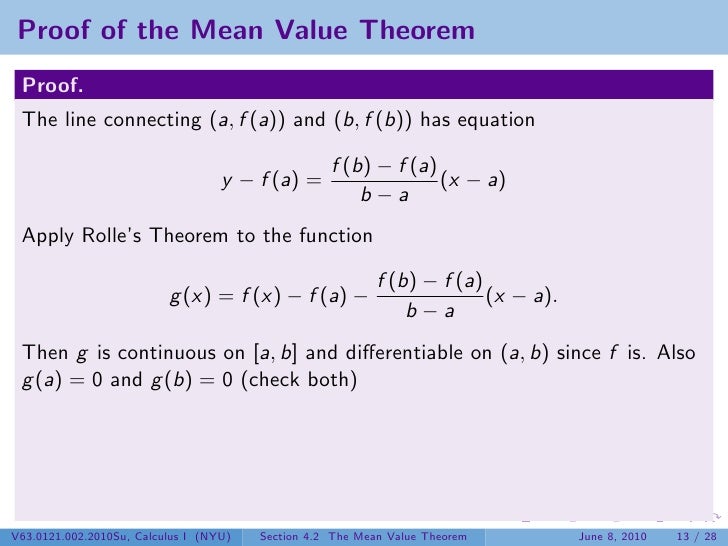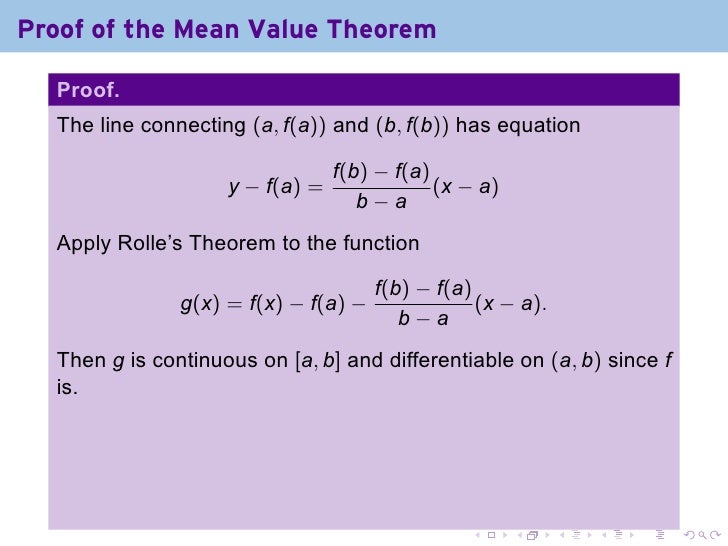
Let $A$ be the point $(a,f(a))$ and $B$ be the point $(b,f(b))$.

In order to indicate this dependence, one gives the new function the name derived function, and designates it with the aid of an accent by the notation y ′ y' y ′ or f ′ ( x ) f '(x) f ′ ( x ).If $f$ is a function that is continuous on $$ and differentiable on $(a,b)$, then there exists some $c$ in $(a,b)$ where As for the original proofs, it is highly unlikely that the original will be easy to read. If the proof you have does not include a drawing, make some drawing for yourself and then it should be clear where the auxiliary function is coming from. S n + 1 − S n = u n S_ D y D x = i f ( x + i ) − f ( x ) will depend on the proposed function y = f ( x ) y = f (x) y = f ( x ). Lagrange's Mean Value Theorem is nothing but a tilted version of Rolle's Theorem. The Mean Value Theorem relates the derivative of a function to values of. This approachable text provides a comprehensive understanding of the necessary techniques and concepts of the typical. Substantial portions of the content, examples, and diagrams have been redeveloped, with additional contributions provided by experienced and practicing instructors. Guichard, has been redesigned by the Lyryx editorial team. If an infinitesimal change in x is denoted as dx, then the derivative of y. Extreme Value Theorem, which says that any real valued continuous function on a closed. It is known as the derivative of the function f, with respect to the variable x. In other words, the function f ( x ) f (x) f ( x ) will remain continuous with respect to x x x between the given limits if, between these limits, an infinitely small increment of the variable always produces an infinitely small increment of the function itself. proof-based course in one-variable calculus and analysis. Calculus: Early Transcendentals, originally by D. The proof of the theorem is given using the Fermats Theorem and the. Generalized mean value theorem We now turn to a more general form of the mean value theorem. In any interval the mean value theorem tells us that the difference in f between its endpoints is their separation times the derivative of f at some. Given this, the function f ( x ) f (x) f ( x ) will be a continuous function of this variable within the two limits assigned to the variable x x x if, for every value of x x x between these limits, the absolute value of the difference f ( x + a ) − f ( x ) f (x + a) - f (x) f ( x + a ) − f ( x ) decreases indefinitely with that of a a a. Therefore, using (1), we get (1 + x) > 1 + x. If, beginning from one value of x x x lying between these limits, we assign to the variable x x x an infinitely small increment a a a, the function itself increases by the difference f ( x + a ) − f ( x ) f (x + a) - f (x) f ( x + a ) − f ( x ), which depends simultaneously on the new variable a a a and on the value of x x x. Let f ( x ) f (x) f ( x ) be a function of a variable x x x, and let us suppose that, for every value of x x x between two given limits, this function always has a unique and finite value. When the successive absolute values of a variable decrease indefinitely in such a way as to become less than any given quantity, that variable becomes what is called an infinitesimal.

The function from the previous example was undefined at (0,0), but using the value we found for the. When the values successively attributed to the same variable approach indefinitely a fixed value, eventually differing from it by as little as one could wish, that fixed value is called the limit of all the others. April 17, 2015: More on Mean Value, Taylors Theorem. By determining these conditions and these values, and by fixing precisely the sense of all the notations I use, I make all uncertainty disappear. We must even note that they suggest that algebraic formulas have an unlimited generality, whereas in fact the majority of these formulas are valid only under certain conditions and for certain values of the quantities they contain.
Proof of mean value theorem using infinitesimals series#
Reasons for this latter approach, however widely they are accepted, above all in passing from convergent to divergent series and from real to imaginary quantities, can only be considered, it seems to me, as inductions, apt enough sometimes to set forth the truth, but ill founded according to the exactitude which is required in the mathematical sciences. The Mean Value theorem states the following: there exists a number c such that a < c < b and. Cauchy's approach to the calculus:Īs for my methods, I have sought to give them all the rigour which is demanded in geometry, in such a way as never to fall back on reasons drawn from what is usually described in algebra.

In it he attempted to make calculus rigorous and to do this he felt that he had to remove algebra as an approach to calculus.

Cauchy wrote Cours d'Analyse (1821) based on his lecture course at the École Polytechnique.


 0 kommentar(er)
0 kommentar(er)
